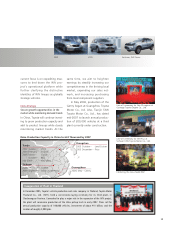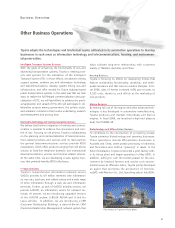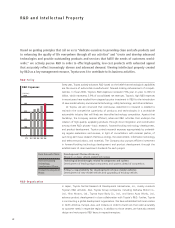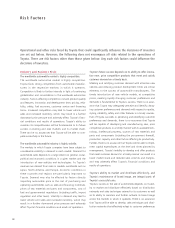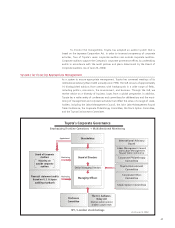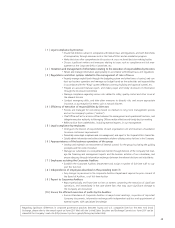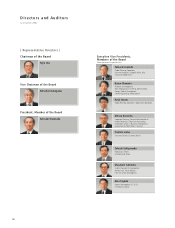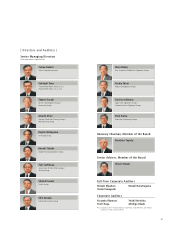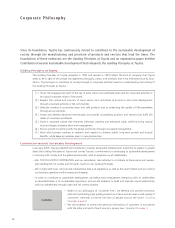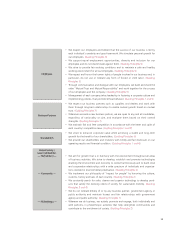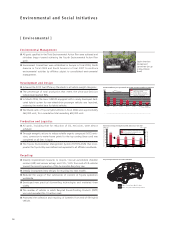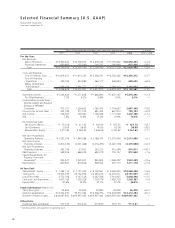Toyota 2006 Annual Report Download - page 51
Download and view the complete annual report
Please find page 51 of the 2006 Toyota annual report below. You can navigate through the pages in the report by either clicking on the pages listed below, or by using the keyword search tool below to find specific information within the annual report.
49
(1) Legal compliance by Directors
• Ensure that Directors will act in compliance with relevant laws and regulations, and with the Articles
of Incorporation, through measures such as the Code of Ethics and an orientation program
• Make decisions after comprehensive discussions at cross-sectional decision-making bodies
• Discuss significant matters and measures relating to issues such as compliance and risk man-
agement at the Corporate Ethics Committee, etc.
(2) Retention and management of information relating to the execution of responsibilities by Directors
•
Retain and manage information appropriately in accordance with relevant laws and regulations
(3) Regulations and other systems related to the management of risks of losses
• Properly manage capital funds through the budgeting system and other forms of control, and con-
duct our business operations and manage our budget based on the authorities and responsibilities
in accordance with the “Ringi” system (effective consensus-building and approval system), etc.
• Prepare an accurate financial report, and make proper and timely disclosure of information
through the Disclosure Committee
• Manage compliance regarding various risks related to safety, quality control and other issues at
the relevant division
• Conduct emergency drills, and take other measures to diversify risks and secure appropriate
insurance, as a precaution for events such as natural disasters
(4) Efficiency of execution of responsibilities by Directors
• Policies are managed for consistency based on medium to long term management policies
and on the Company’s policies (“Hoshin”)
• Chief Officer will act as a liaison officer between the management and operational functions, and
delegate executive authority to Managing Officers realize effective and timely decision making
• Reflect advice from stakeholders, including external experts, in our management
(5) Legal compliance by employees
• Distinguish the division of responsibilities of each organization unit and maintain a foundation
to ensure continuous improvements
•
Periodically review legal compliance and risk management, and report to the Corporate Ethics Committee
•
Quickly obtain information and achieve immediate solutions utilizing various hotlines in the Company
(6) Appropriateness of the business operations of the group
• Develop and maintain an environment of internal controls for the group by sharing the guiding
principles and the code of conduct
• Manage our subsidiaries in a comprehensive manner through divisions of the Company that man-
age the financing and management aspects and the business activities of our subsidiaries, and
ensure adequacy through information exchanges between the relevant divisions and subsidiaries
(7) Employees assisting the Corporate Auditors
• Establish the Corporate Auditors Department and assign a number of full-time staff to sup-
port this function
(8) Independence of employees described in the preceding item (7)
• Any changes in personnel in the Corporate Auditors Department require the prior consent of
the Board of Auditors, or of full-time Auditor
(9) Report to Corporate Auditors
• Report periodically and from time to time on matters concerning the execution of significant
operations, and immediately in the case where facts that may cause significant damage to
the Company are discovered
(10) Ensure the efficient execution of audits by the Auditors
• Ensure attendance of Corporate Auditors at major board meetings, inspection of important
Company documents, information exchange with independent auditors and appointment of
external experts with specialized knowledge
Regarding significant differences in corporate governance practices between Toyota and U.S. companies listed on the New York Stock
Exchange, please refer to the annual report on Form 20-F filed with the United States Securities and Exchange Commission. Form 20-F can be
viewed at the Company’s web site (http://www.toyota.co.jp/en/ir/library/sec/index.html).


